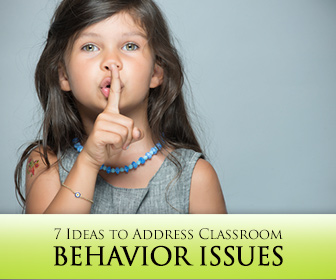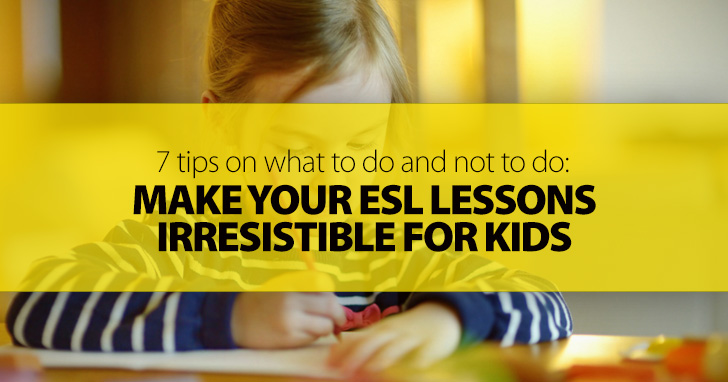How to Address Classroom Behavior Issues: 7 Ideas to Keep Your Kids Organized and Productive


I'd like all of you to think about the following question and if possible answer it truthfully. Do your kids enjoy the lessons you provide? Are they anxious for you to start the lessons and get their learning on? If the answer is yes, you are an awesome teacher but I'm sure even you can give your lessons an extra something. If the answer is sometimes, it's totally normal. I mean, we all have our days, but it means you need to work on making your lessons a bit more appealing. If the answer is no, don't sweat it, these easy steps will definitely come in handy. Making your kids lesson irresistible is easier than you think. It really doesn't require much more work than planning an ordinary lesson.

Picture this, there is a teacher sitting behind a desk or at a table as children come into a class. She/he says good morning/afternoon and then asks them to open their books and inquires about homework. I've got one word to describe this, boring. This is not the way to start a lesson. It is completely unappealing and is lacking everything kids would probably find even remotely interesting. So what you need to do is give your kids a reason to want to start the lesson. You need to do something the will boost their energy. Depending on their age, an amazing way to start is to sing a song. Choose one that has some movement in it. If kids are very young (4-6 years old), you can start with the same song every lessons. It is a great activity to put at the beginning of your lesson structure. That way kids know the lesson is starting and they will also remember what follows. With older kids and teens you can ask them to choose some songs (appropriate for lessons) and play them as they come in and settle down. If they know the song they can start singing as they come in. It's important to give them something to do the minute they come in and songs are incredible. When they are all present or after the song ends, you can start the lesson.
If you teach kids you know very well that you wouldn't use the same activities with kids that are 6 and those who are 10 or 13. We've talked about developmental stages before. It's important to take into consideration what kids are like and what they can do at different ages. For instance, playing a game with 4-5 year-old kids where they need to participate in a group, is not recommendable. Kids this age have trouble sharing and are just starting become aware of others' needs. In addition to abilities, we also need to consider their likes and dislikes. This is simple since it requires no research on your behalf. Just ask them what they like, and what kind of activities they enjoy more. Easy as cake!
Planning is essential in all ESL lessons but when teaching kids, it's crucial. Not just for you as the teacher, for the kids as well. They need to know there is a plan, a structure. They need to know you are not just winging it. Structure and routines are incredibly important for kids in life as well as in the classroom. Not knowing what to expect and what will happen makes kids feel insecure and that might cause them to embrace the chaos or for others, feel very uncomfortable and not want to be there. A great activity to do after the welcome song is to share the plan with them. Write a summarized version of what will be done and what the objectives are for them in that lesson. As objectives are completed kids can take turns putting a check next to them.
Issues with behavior are always difficult to handle. We've discussed how to deal with these issues in other articles. Essentially, to avoid issues what you need to do is to make sure that classroom rules are clear to everyone as well as what behavior is appropriate and inappropriate. Everyone needs to be on board and you need to address issues with behavior as soon as they come up. Also, classroom issues start coming up when there is too much time between one activity and the next. Always make sure they are busy. If some kids are faster than others, prepare extra activities and keep them handy. Time for idle just translates into disaster.
Assigning activities from a workbook for homework is fine, once in a while, but even homework can be fun if you put some thought into it. A great example of a fun assignment is to watch an episode from a popular cartoon in English from Youtube. Make sure you have watched it first. Ask them to watch it and identify specific words, verbs, sentences etc. Then you can ask the kids to write a summary of what the episode was about. Believe me, they'll be a lot more willing to do this type of activity than any other.
We all have a special skill we can put to use in the ESL classroom. Some ESL teachers can sing or play an instrument. Some are amazing artists or great at making up fun stories or are incredibly funny. Any skill can be used in the classroom to give your lesson a certain zest that makes it unique. Be creative and try to find a way to work your skills into you lesson. It will make it more enjoyable for both you and the kids.
Kids are incredibly curious, you can get their attention in a minute just by showing them a box or bag and saying something like, guess what's in here. They'll go nuts trying to guess and you'll have their attention in a seconds. So, use their curiosity to your advantage by giving them a glimpse of what you might be doing the following class. Give them something to look forward to but don't tell them everything, just give them a hint.
Just make sure you have all the right ingredients to cook.